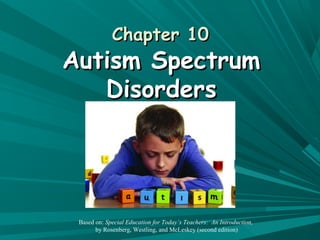
Chapter 10: Autism Spectrum Disorders
- 1. Chapter 10 Autism Spectrum Disorders Based on: Special Education for Today’s Teachers: An Introduction, by Rosenberg, Westling, and McLeskey (second edition)
- 2. Chapter 10 Questions What are the prevalence rates for and causal factors associated with Autism Spectrum Disorders? How are Autism and Asperger’s disorder defined? What are common characteristics of Autism? How are students with Autism identified? What educational practices are effective in improving outcomes for students with Autism?
- 3. Prevalence About 1 in 88 children according to the CDC. Almost 5 times more common among boys. Increase due to changes in diagnostic criteria, awareness, parental age, and environment.
- 4. Causal Factors No Known Single Cause! Nature-based factors Genetic Neurochemical Brain structure Nurture-based factors Parents or vaccines do not cause autism! Environmental factors (parental age, pregnancy, birth, toxins, etc.)?
- 5. Austism Spectrum Disorders High Functioning Low Functioning Level 3: Needs Very Substantial Support (e.g., Asperger Syndrome) Level 2: Needs Substantial Support (For more info, see DSM-V Criteria.) Level 1: Needs Some Support
- 6. How Does Autism Vary? Symptoms can range from mild to severe. 62% have average or above intelligence 83% have comorbid disorders (developmental, psychiatric, neurologic, chromosomal, genetic). About a third can sustain supported or partial independence as adults.
- 7. IDEA Definition of Autism • Significantly affects verbal and nonverbal communication and social interaction • Generally evident before age 3 • Adversely affects educational performance • Other characteristics may include: engagement in repetitive activities and stereotyped movements resistance to environmental change or change in daily routines unusual responses to sensory experiences
- 8. New DSM V -Diagnostic Criteria* Deficits in social communication and social interaction (all 3 criteria) Restricted, repetitive patterns of behavior, interests, or activities (2 of 4 criteria) *DSM-5 criteria are more in line with IDEA criteria, than were the DSM-4 criteria.
- 9. Asperger Syndrome (aka high-functioning autism) Minimal impairment in language and cognition High level of vocabulary, but very literal Impaired social communication, self-centered Difficulty with non-verbal communication Inappropriate or minimal social interaction Likes sameness, difficulty with change Unusual preoccupations or rituals Awkward movements, odd mannerisms
- 10. Communication About 25% are non-verbal Echolalia (repeating others’ words, “movie talk”) Monotonous tone, unusual pitch and rhythm Difficulty carrying on a conversation Difficulty with non-verbal communication (e.g., body language, gestures, facial expressions, eye contact)
- 11. Social Interaction Limited social interaction Reduced sharing of interests, emotions Difficulty developing, maintaining and understanding relationships Trouble regulating emotions or behavior Poor or unusual play behavior
- 12. Repetitive/Restrictive Behaviors Repetitive movements--hand flapping, rocking Excessive need for sameness, routines, rituals Unusual fascination with certain objects, parts of objects, topics, or activities Failure to engage in imaginative play
- 13. Unusual Responses to Sensory Experiences Highly sensitive/adverse reaction to certain sounds, textures, tastes, smells, etc. Insensitive/oblivious to some sensations Crave certain movements or sensations such as pressure, spinning, etc. Difficulty filtering sensory input.
- 14. Identification of ASD Multidisciplinary team (doctors, psychologist, speech therapist, social worker, educator) Assessment over time in multiple settings Rating scales, diagnostic interviews, direct observation of social and communicative behaviors Most cases of autism diagnosed by age 4, but Asperger’s may not be diagnosed until age 6.
- 15. Interventions Early intervention focusing on sensory issues, communication, and social skills Academic interventions for high-functioning students similar to those for ADHD and LD. Applied behavior analysis, discrete trials, functional behavioral analysis Social skills instruction (e.g., social stories, cartooning, scripts, power cards) For verbal students, speech therapy focusing on pragmatics (social use of lang.) For non-verbal students, communication boards, PECS, electronic devices
Notas do Editor
- -Autism occurs on a “Spectrum” from less Severe to More Severe. LOOK at TABLE: COMPARISON OF AUTISM, HFA, AS AND ASD/PDD NOS…The only variables are IQ and male to female ratio/age of onset… other characteristics merely change in degree. Therefore – everything that we talk about today is applicable to all students on the spectrum – just to greater and lesser degrees. For Example: Students with HFA/Asperger Syndrome still need schedules, structured teaching and visuals – but perhaps they will be written words instead of pictures and perhaps it can mean a file folder system or check list instead of an object schedule and independent work system. So, throughout the training – always be thinking “How can I take this concept and apply it to the student in my class.” On another note… these strategies are just good teaching techniques and would be effective for ALL students – not just students on the ASD – is effective for students with Emotional Disabilities, LD, etc… So don’t think that you need to only do this for the Autistic students in your class.
